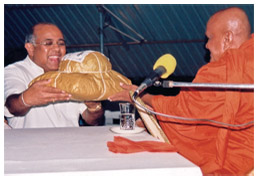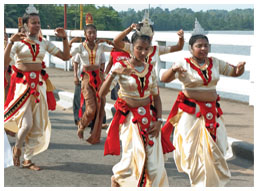
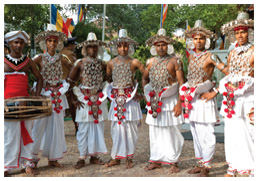
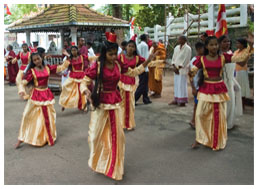
Cultural Activities
In Sinhala culture, when a girl or a boy graduates from a School of Oriental Dancing, their debut or first public performance revolves around a beautiful and poignant ceremony that is performed before
their parents, usually on sacred grounds. For this, what better than the hallowed precincts of the Kalutara Bōdhi! The debutantes form a group of dancers, both boys and girls, and make their symbolic
offerings to the gods or personifications of the arts – all laid out in containers woven out of fresh and tender leaves of the coconut palm and placed on an improvised tripod.
The girls have their tresses upswept and tied in knots. They kneel in a dance pose before the parents. The mother places the Sheersha Ābharanaya or ceremonial headgear upon the daughterʼs styled knot of hair. This event is referred to in Sinhala as Pāyinpath Pǽlendaveema (ceremonially placing the intricate headgear).
In the case of the boys they too kneel in ceremonial style before the parents. The father adorns the sons with the dance masks, the Ves Ābharana Pǽlendaveema. The ceremonial headgear is positioned at a precise, auspicious minute which is determined through the science of stars or astrology. The chorus chants in beautiful tones, reminiscing upon the sustenance drawn from the breast of the mother and from the sweat of the fatherʼs brow, acknowledging the debt to parents and ancestors.
Then formal parental authority is sought by the children to perform before the public. The drumming reaches a crescendo when the auspicious moment arrives, and with a gentle action each parent performs his and her role – placing the headgear or the dance masks. It is a moment of high emotion with tears of joy drenching everyoneʼs face – parents, children and audience. There are moments of veneration devoted to the dancing teachers. The entire event is charged with Buddhist sentiments and laced with teachings of gratitude to parent and teacher, evocative of the best ethical teachings of the Buddha and the most laudable social manners and traits of Sinhala culture.

Upasampadā or Higher Ordination Ceremony
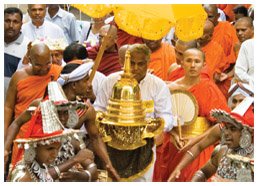
Exposition of the Relics of the Dǽngasauv or Two Chief Disciples of the Buddha
In May 2008, as part of Vesak celebrations, KBT hosted the exposition of the sacred relics of Sāriputta and Mogallāna the Agrashrāvaka or two chief disciples of the Buddha. These relics were excavated from the Sānchi Stūpa in India, by Alexander Cunningham, the famous archaeologist who served in India. A part of the relics was gifted to Sri Lanka by the Government of India in 1955. They are safely preserved at the Sri Lanka Mahā Bōdhi Agrashrāvaka Vihāra in Colombo for the veneration of Buddhists locally and abroad. The Kalutara Bōdhi had the rare honour and privilege of being one of the first ever organisations to be permitted such an exhibition and thousands of devotees flocked to the Kalutara Bōdhi to pay homage to these sacred relics.

Mid-Day Meal For Devotees Who Observe Sil On Poya Days and Week-Ends
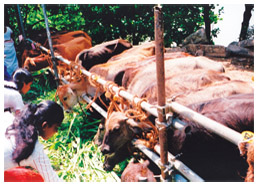
Rescue of Cattle from Slaughter Houses
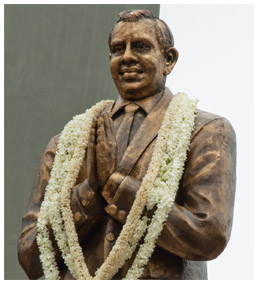
Unveiling of a Statue of Sir Cyril de Zoysa at Kataragama
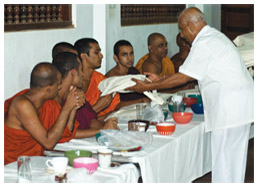
Almsgiving at Kataragama
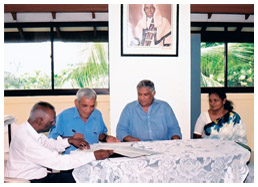
Meditation Centre in Waskaduwa
